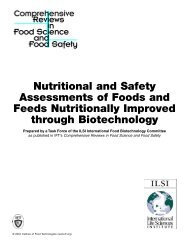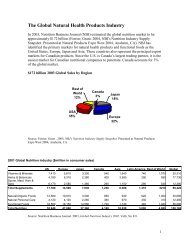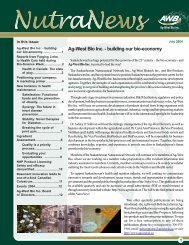Beyond Borders: Global biotechnology report 2010
Beyond Borders: Global biotechnology report 2010
Beyond Borders: Global biotechnology report 2010
You also want an ePaper? Increase the reach of your titles
YUMPU automatically turns print PDFs into web optimized ePapers that Google loves.
Deals<br />
A new landscape<br />
Given the realities of a restricted fundraising<br />
environment for <strong>biotechnology</strong><br />
companies, coupled with the continued<br />
need for pharmaceuticals companies to<br />
fill their pipeline gaps, it was reasonable<br />
to expect 2009 to be another strong year<br />
on the transactions front. Instead, M&A<br />
activity declined significantly, and the year<br />
saw only three acquisitions larger than<br />
US$1 billion. Mega-mergers (transactions<br />
larger than US$10 billion) involving biotech<br />
companies were essentially absent, other<br />
than the completion of Roche’s tender for<br />
Genentech, which really began in 2008.<br />
The number of strategic alliances remained<br />
relatively flat compared to the last several<br />
years, while their total potential value<br />
(“biobucks”) declined to 2007 levels.<br />
It is important to put what might appear<br />
to be relatively lackluster totals in context<br />
by pointing out what they are relative to.<br />
Both 2007 and 2008 were exceptionally<br />
strong years from a deals perspective,<br />
with the industry reaching all-time highs<br />
on several fronts. As such, holding ground<br />
on strategic alliances is hardly shabby.<br />
And the distribution of M&As has often<br />
been inherently lumpy, since these are<br />
larger, less frequent transactions, and<br />
since buyers often pause to digest their<br />
acquisitions after making large purchases.<br />
As such, it may well be premature to<br />
over-interpret what could prove to be a<br />
one-year hiatus in the action.<br />
Mega distractions<br />
While the fundamentals driving<br />
transactions haven’t changed, some basic<br />
realities did — particularly for big pharma<br />
(the buy side of most biotech deals). Over<br />
the last several years, companies across<br />
the pharmaceutical industry have been<br />
revising and refining their strategies, and<br />
this resulted in several mega-mergers<br />
in 2009. The action started in January,<br />
when Pfizer announced that it would join<br />
forces with Wyeth. This was followed in<br />
March by Merck’s announcement that it<br />
was merging with Schering-Plough and<br />
the completion of Roche’s tender offer for<br />
the minority stake in Genentech. When<br />
one adds Novartis’ two-step acquisition<br />
from Nestlé of a majority interest in Alcon<br />
(the second step of which closed in <strong>2010</strong>),<br />
the total value transferred in just these four<br />
transactions exceeded US$200 billion —<br />
handily surpassing the combined value of all<br />
pharma-biotech acquisitions over the last<br />
decade.<br />
The impact of this consolidation on<br />
deal-making with the biotech industry<br />
extends beyond the use of capital and the<br />
Selected 2009 M&As<br />
Company Country<br />
76 <strong>Beyond</strong> borders <strong>Global</strong> <strong>biotechnology</strong> <strong>report</strong> <strong>2010</strong><br />
additional debt burden carried by some<br />
companies. In the short term, despite claims<br />
by the mega-merger participants that they<br />
remain open for business with biotech,<br />
it is clear such large transactions create<br />
significant integration challenges that are a<br />
major distraction for management. <strong>Beyond</strong><br />
all the inward-focused politics of who will get<br />
what position is the very real need to realize<br />
synergies by rationalizing the product<br />
portfolio and pipeline. Until the dust settles,<br />
it is difficult for business development<br />
functions to move aggressively in pursuit<br />
of new technologies or to credibly argue<br />
that they are the “partner of choice” for<br />
a particular asset. Indeed, none of the<br />
acquirers in these mega-mergers undertook<br />
a significant biotech acquisition in 2009,<br />
although, with the exception of Pfizer, they<br />
did remain active in strategic alliances.<br />
Acquired or<br />
merged company Country<br />
Value<br />
(US$m)<br />
Dainippon Sumitomo Japan Sepracor US 2,600<br />
Bristol-Myers Squibb US Medarex US 2,400<br />
Gilead Sciences US CV Therapeutics US 1,400<br />
Johnson & Johnson US Cougar Biotechnology US 970<br />
H. Lundbeck Denmark Ovation Pharmaceuticals US 900<br />
Onyx Pharmaceuticals US Proteolix US 851<br />
Celgene US Gloucester Pharmaceuticals US 640<br />
Endo Pharmaceuticals US Indevus Pharmaceuticals US 637<br />
Novartis Switzerland CorThera US 620<br />
Alcon Switzerland ESBATech Switzerland 589<br />
sanofi-aventis France Fovea Pharmaceuticals France 514<br />
sanofi-aventis France BiPar Sciences US 500<br />
Source: Ernst & Young, Windhover Information, MedTRACK, BioWorld and company news via NewsAnalyzer








